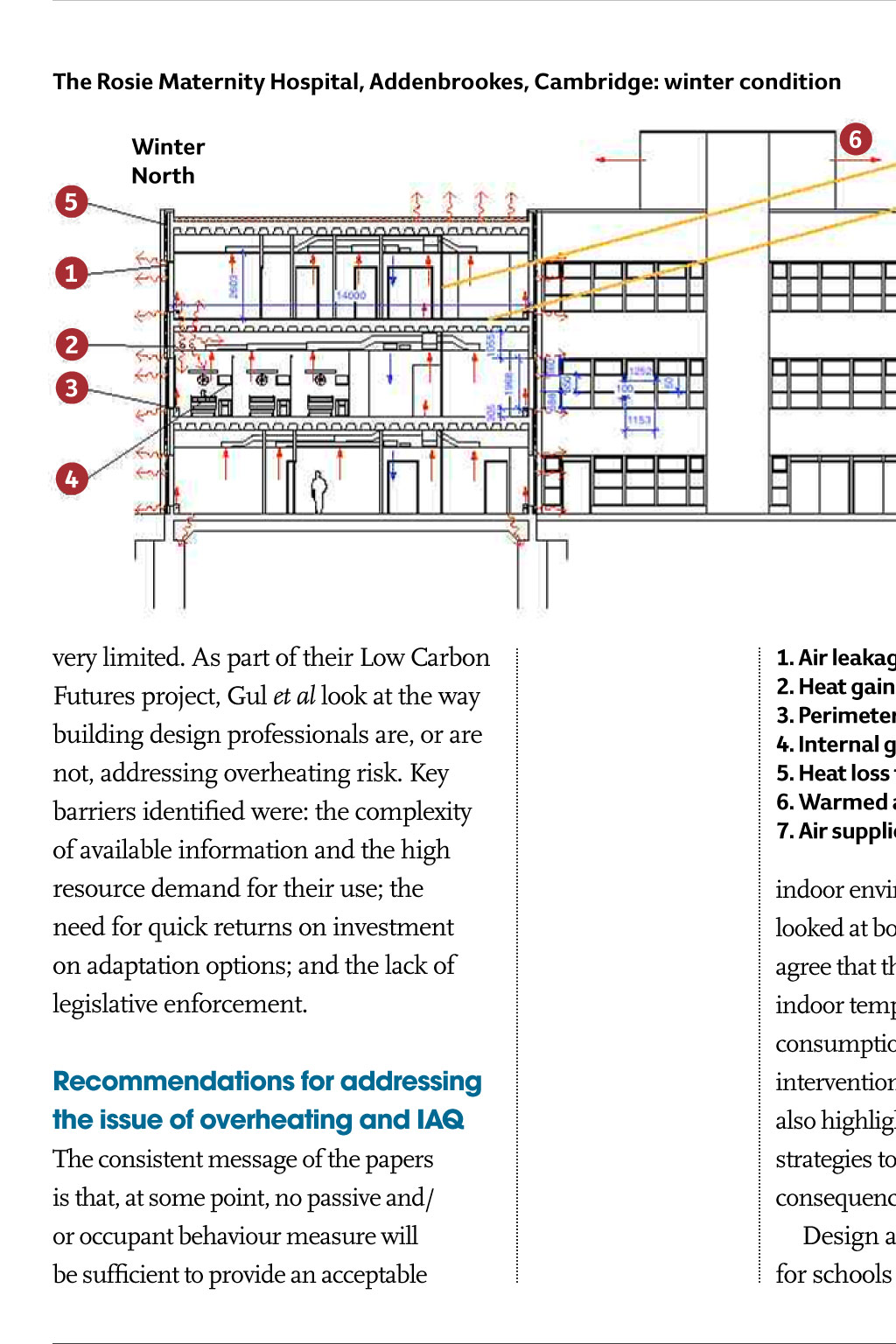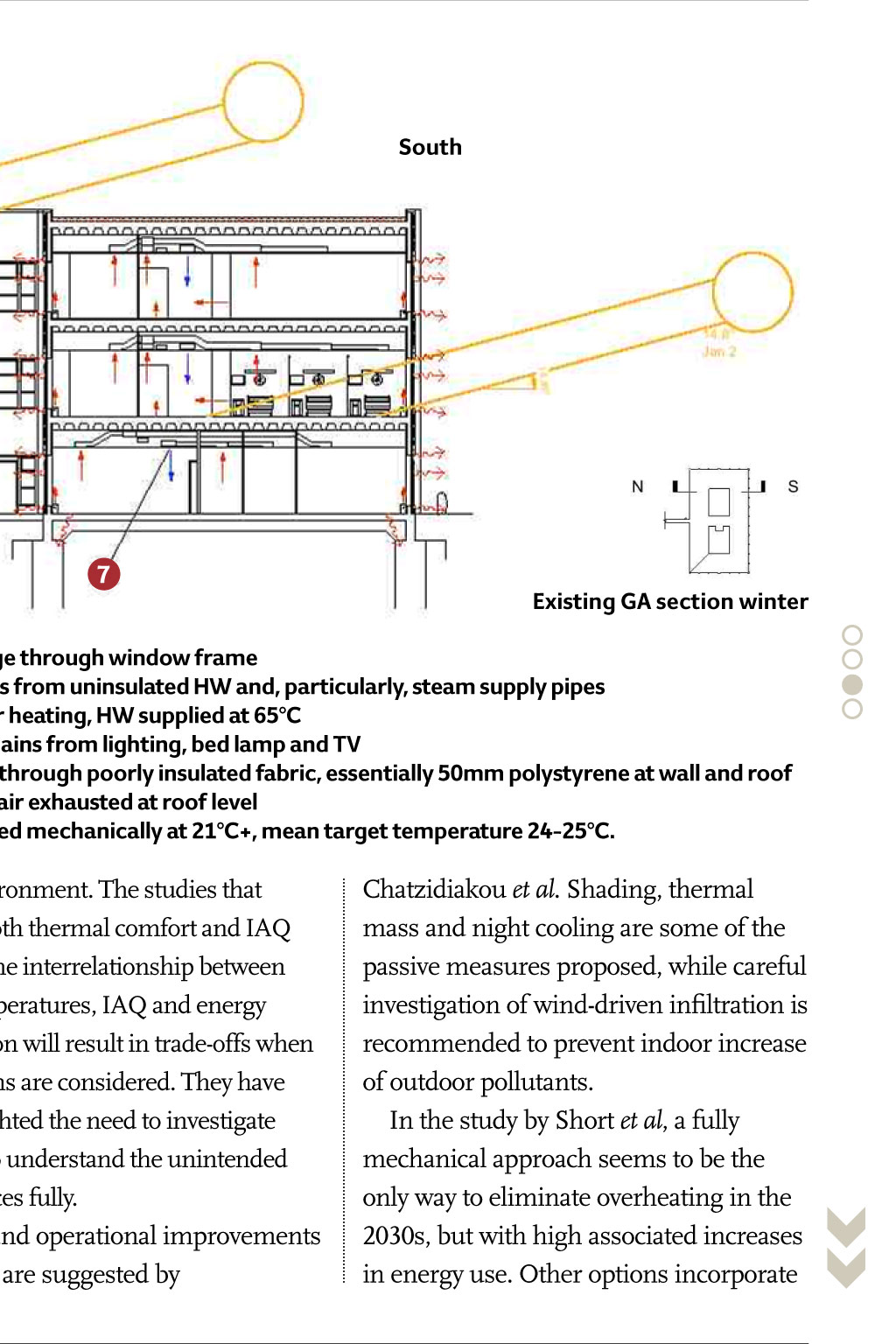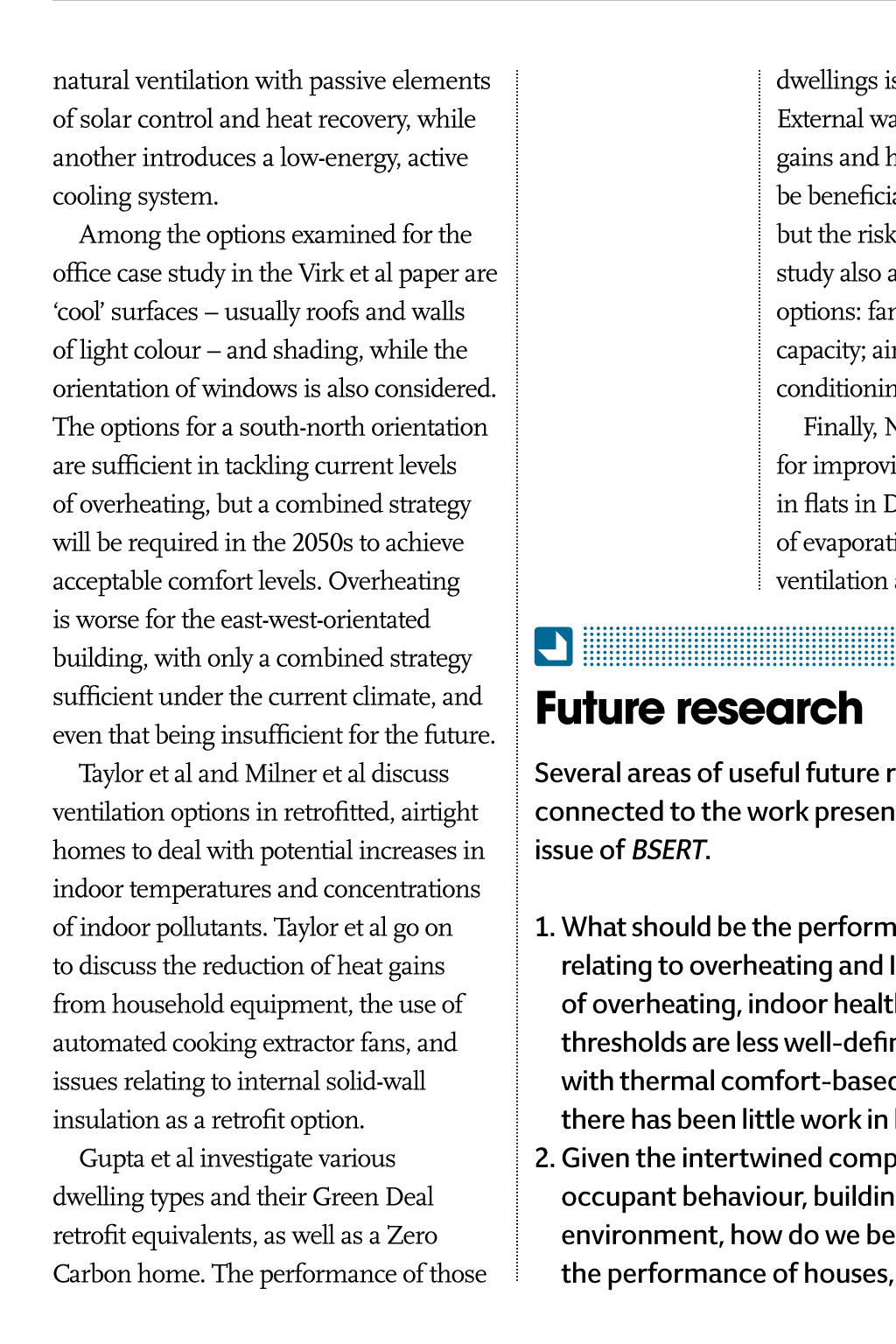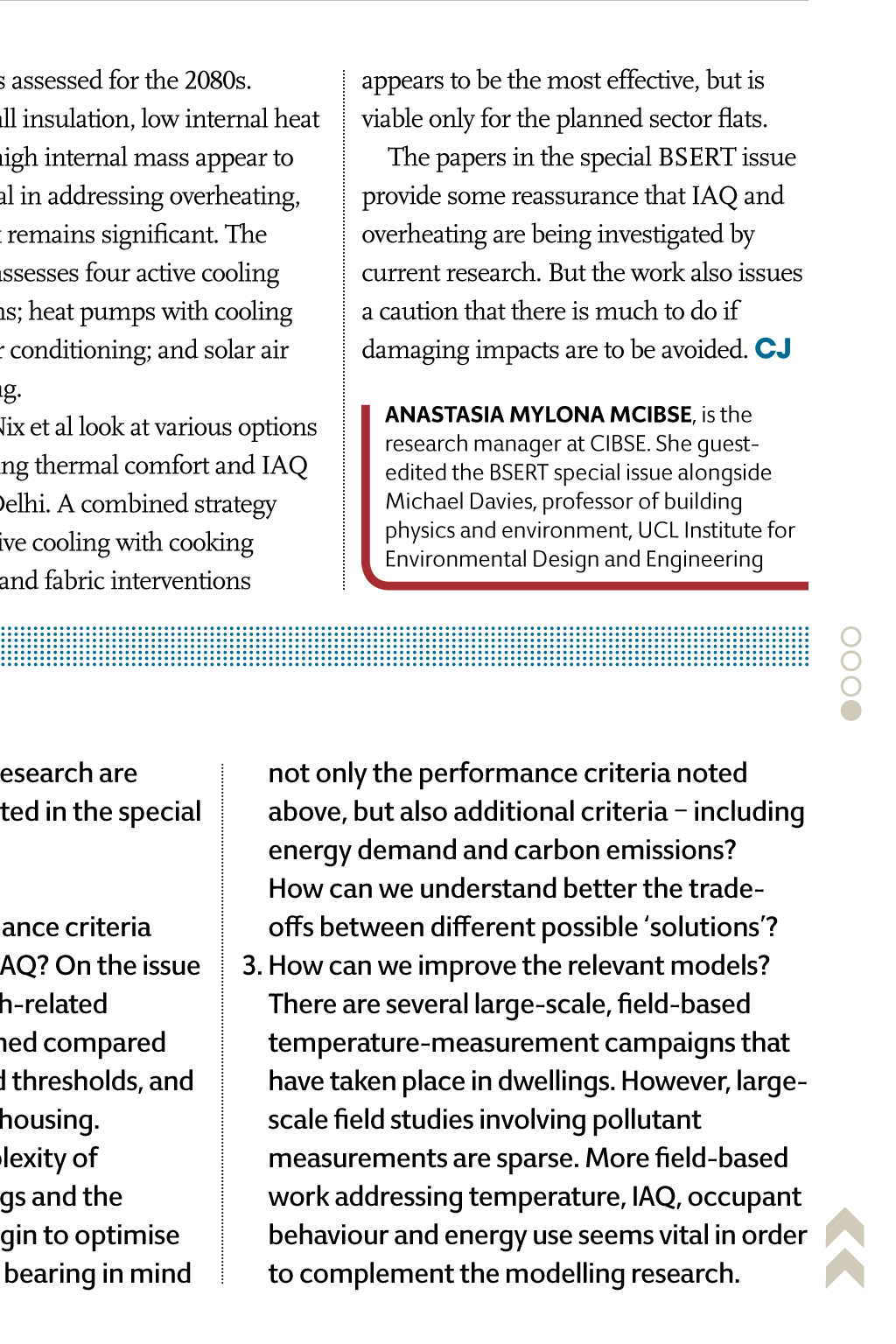
















Case Study Overheating And Indoor Air Quality Expanding cities and the threat of a changing climate are driving the building services industry to design and manage buildings with lower impacts on the environment. In the UK, much attention has been paid to the winter performance of buildings in order to reduce heat loss, and to save energy. However, there must also be consideration of the effect that highly insulated and airtight spaces have on indoor air quality (IAQ) and overheating. In addition, rising temperatures caused by climate change and urbanisation might render conventional cooling measures such as shading and opening windows insufficient, especially given the potential for pollution ingress, noise and security breaches. The March issue of the Building Services Engineering Research and Technology Journal (BSERT) focuses on the latest research around overheating and IAQ. This demonstrates the importance of looking at the overall performance of a building to avoid the unintended consequences of pursuing energy efficiency goals. The special issue considers the future performance of buildings that have been designed or retrofitted to current requirements, and STRIKING a BalancE Increasing energy efficiency without compromising indoor environmental quality is one of the biggest challenges facing building services engineers. Anastasia Mylona highlights research from a special issue of the Building Services Engineering Research and Technology Journal that aims to help engineers design low carbon and healthy buildings remain zero carbon in the future, based on their potential need for increased ventilation and cooling under a warmer climate. Chatzidiakou et al investigate the interrelation between indoor temperature, IAQ and ventilation in school buildings. Nix et al undertake a weighted multiobjective assessment involving energy demand, cost, indoor temperature and IAQ to explore options for housing in Delhi. These, and the other papers, highlight the complexity of achieving healthy indoor environments while meeting energy efficiency targets. offers recommendations for addressing the issues around overheating and IAQ. reduced concentration of pollutant ingress Taylor et al and Milner et al address the strong interrelation between indoor temperature, IAQ, ventilation and energy consumption. Taylor et al show that higher internal temperatures during summer can increase pollutant ingress from outdoors as a result of increased ventilation to cope with the overheating. This same mechanism would lead to a reduced concentration of pollutants from indoor sources. Conversely, when ventilation is reduced, pollutant concentrations from indoor sources may increase, along with indoor temperatures. Milner et al show that reducing infiltration rates in homes without an appropriate, associated ventilation strategy could have a negative effect on occupant health, with appreciable economic costs. Taylor et al and Gupta et al examine the summer performance of various housing types and demonstrate that those retrofitted for energy efficiency can experience higher overheating risk than their non-retrofit equivalent. Specifically, Gupta et al question whether zero carbon homes as designed today will eadE RMOR MORE INFORMATION future performance The future performance of various building types has been examined in a large body of research, especially since the release of the UK Climate Projections in 2009 (UKCP09). Its conclusions are consistent; indoor thermal comfort and IAQ will diminish unless building design practices address the issue now. In the special issue of BSERT, five studies look at the performance of buildings in the future, while one looks at the perception of the risk of overheating by industry professionals. Taylor et al show that, as the climate warms, retrofitting for energy efficiency can increase the risk of overheating and poor IAQ. High demand for homes may result in more houses being converted into flats, which may increase vulnerability to these problems. Short et al, Gupta et al and Virk et al look, respectively, at the future overheating risk of a hospital retrofit, the UKs housing stock, and offices in the urban climate of London. In the case of the hospital, considerable overheating risk was identified under the current climate, which would intensify in the future. Similarly, Gupta et al conclude that a new performance gap could result from not planning for future overheating and cooling systems. Based on that analysis, the UK will need to adapt to the changing electricity demand for cooling in the future, as most of the UK housing stock will require some type of mechanical cooling by the 2050s. Virk et al examine the practical use of the new CIBSE TM49 Design Summer Years for London, which aims to provide a resource that will enable the industry to assess the thermal performance of its designs within the urban environment and for future climates. Although the messages about future performance are consistent, the assessment of buildings future performance at the design stage is still The Rosie Maternity Hospital, Addenbrookes, Cambridge: winter condition 5 1 2 3 4 6 Winter North South MORE INFORMATION The BSERT special issue was funded by the Adaptation and Resilience in the Context of Change (ARCC). Visit ARCC for more details. BSERT is available for CIBSE Members to download for free from the CIBSE Knowledge Portal. 7 very limited. As part of their Low Carbon Futures project, Gul et al look at the way building design professionals are, or are not, addressing overheating risk. Key barriers identified were: the complexity of available information and the high resource demand for their use; the need for quick returns on investment on adaptation options; and the lack of legislative enforcement. recommendations for addressing the issue of overheating and IaQ The consistent message of the papers is that, at some point, no passive and/ or occupant behaviour measure will be sufficient to provide an acceptable natural ventilation with passive elements of solar control and heat recovery, while another introduces a low-energy, active cooling system. Among the options examined for the office case study in the Virk et al paper are cool surfaces usually roofs and walls of light colour and shading, while the orientation of windows is also considered. The options for a south-north orientation are sufficient in tackling current levels of overheating, but a combined strategy will be required in the 2050s to achieve acceptable comfort levels. Overheating is worse for the east-west-orientated building, with only a combined strategy sufficient under the current climate, and even that being insufficient for the future. Taylor et al and Milner et al discuss ventilation options in retrofitted, airtight homes to deal with potential increases in indoor temperatures and concentrations of indoor pollutants. Taylor et al go on to discuss the reduction of heat gains from household equipment, the use of automated cooking extractor fans, and issues relating to internal solid-wall insulation as a retrofit option. Gupta et al investigate various dwelling types and their Green Deal retrofit equivalents, as well as a Zero Carbon home. The performance of those Existing GA section winter 1. Air leakage through window frame 2. Heat gains from uninsulated HW and, particularly, steam supply pipes 3. Perimeter heating, HW supplied at 65C 4. Internal gains from lighting, bed lamp and TV 5. Heat loss through poorly insulated fabric, essentially 50mm polystyrene at wall and roof 6. Warmed air exhausted at roof level 7. Air supplied mechanically at 21C+, mean target temperature 24-25C. indoor environment. The studies that looked at both thermal comfort and IAQ agree that the interrelationship between indoor temperatures, IAQ and energy consumption will result in trade-offs when interventions are considered. They have also highlighted the need to investigate strategies to understand the unintended consequences fully. Design and operational improvements for schools are suggested by Chatzidiakou et al. Shading, thermal mass and night cooling are some of the passive measures proposed, while careful investigation of wind-driven infiltration is recommended to prevent indoor increase of outdoor pollutants. In the study by Short et al, a fully mechanical approach seems to be the only way to eliminate overheating in the 2030s, but with high associated increases in energy use. Other options incorporate dwellings is assessed for the 2080s. External wall insulation, low internal heat gains and high internal mass appear to be beneficial in addressing overheating, but the risk remains significant. The study also assesses four active cooling options: fans; heat pumps with cooling capacity; air conditioning; and solar air conditioning. Finally, Nix et al look at various options for improving thermal comfort and IAQ in flats in Delhi. A combined strategy of evaporative cooling with cooking ventilation and fabric interventions appears to be the most effective, but is viable only for the planned sector flats. The papers in the special BSERT issue provide some reassurance that IAQ and overheating are being investigated by current research. But the work also issues a caution that there is much to do if damaging impacts are to be avoided. cJ ANASTASIA MyLoNA MCIBSE, is the research manager at CIBSE. She guestedited the BSERT special issue alongside Michael Davies, professor of building physics and environment, UCL Institute for Environmental Design and Engineering future research Several areas of useful future research are connected to the work presented in the special issue of BSERT. 1. What should be the performance criteria relating to overheating and IAQ? On the issue of overheating, indoor health-related thresholds are less well-defined compared with thermal comfort-based thresholds, and there has been little work in housing. 2. Given the intertwined complexity of occupant behaviour, buildings and the environment, how do we begin to optimise the performance of houses, bearing in mind not only the performance criteria noted above, but also additional criteria including energy demand and carbon emissions? How can we understand better the tradeoffs between different possible solutions? 3. How can we improve the relevant models? There are several large-scale, field-based temperature-measurement campaigns that have taken place in dwellings. However, largescale field studies involving pollutant measurements are sparse. More field-based work addressing temperature, IAQ, occupant behaviour and energy use seems vital in order to complement the modelling research.